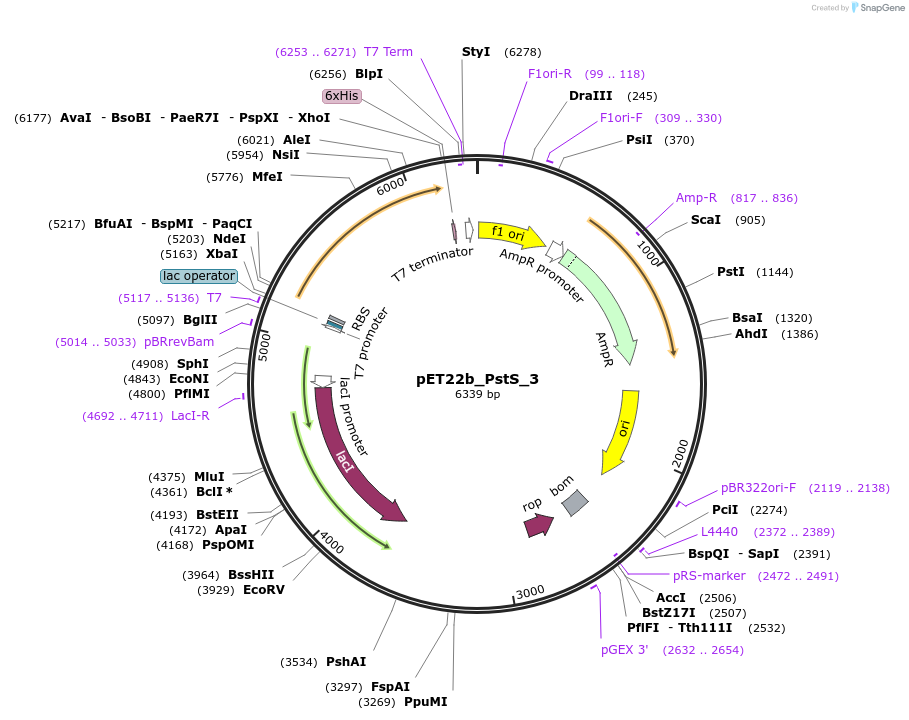-
PurposeExpression of double-cysteine variant of mature phosphate binding protein, PstS, which also has a mutation to weaken phosphate binding, as scaffold for phosphate biosensor
-
Depositing Lab
-
Sequence Information
Ordering
| Item | Catalog # | Description | Quantity | Price (USD) | |
|---|---|---|---|---|---|
| Plasmid | 78200 | Standard format: Plasmid sent in bacteria as agar stab | 1 | $89 | |
Backbone
-
Vector backbonepET22b
-
Vector typeBacterial Expression
Growth in Bacteria
-
Bacterial Resistance(s)Ampicillin, 100 μg/mL
-
Growth Temperature37°C
-
Growth Strain(s)DH5alpha
-
Growth instructionsuse BL21 (DE3) for protein expression
-
Copy numberHigh Copy
Gene/Insert
-
Gene/Insert namepstS (A17C,I76G,A197C)
-
SpeciesE. coli
-
MutationA17C,I76G,A197C (please see depositor comment below)
- Promoter T7
Cloning Information
- Cloning method Restriction Enzyme
- 5′ cloning site NdeI (unknown if destroyed)
- 3′ cloning site XhoI (unknown if destroyed)
- 5′ sequencing primer T7
- 3′ sequencing primer T7 terminal
- (Common Sequencing Primers)
Resource Information
-
Supplemental Documents
Terms and Licenses
-
Academic/Nonprofit Terms
-
Industry Terms
- Not Available to Industry
Trademarks:
- Zeocin® is an InvivoGen trademark.
Depositor Comments
Please note- The numbering system used was for the mature natural wild-type PstS protein. The plasmid produces an extra N-terminal methionine so all mutations will be off by 1nt (e.g., A197C =A198C)
PstS ORF encoding the mature E. coli (A17C, I76G, A197C)PstS protein (PBPw) containing a stop codon at the end of the gene in pET22b (inserted between Nde1 and Xho1 sites in the MCS).
Expression produces MEA at the N-terminus of the mature PstS: So there is an extra M at the N-terminus over the natural, mature PstS. A stop codon was also added at the end of the sequence BEFORE the plasmid-derived His tag. This gives PLY at the C-terminus at the C-terminus of the expressed protein, as in the natural PstS. The amino-acid numbering has been left as based on positions in the natural, mature protein.
Usage
The expressed protein is a weak-binding variant of E. coli phosphate binding protein, PstS. It contains two cysteines (A17C, A197C) and a mutation to weaken binding (I76G). The gene encodes the mature protein without the N-terminal signal peptide, but with an N-terminal methionine. Subsequently the cysteines are labeled with 2 6-iodoactemidotetramethylrhodamines per molecule. This adduct is then used as a phosphate biosensor, having up to 9-fold fluorescence intensity increase on binding inorganic phosphate, with a low dissociation constant so inorganic phosphate can be measured in the tens of micromolar range.
These plasmids were created by your colleagues. Please acknowledge the Principal Investigator, cite the article in which the plasmids were described, and include Addgene in the Materials and Methods of your future publications.
-
For your Materials & Methods section:
pET22b_PstS_3 was a gift from Martin Webb (Addgene plasmid # 78200 ; http://n2t.net/addgene:78200 ; RRID:Addgene_78200) -
For your References section:
Development of a Reagentless Biosensor for Inorganic Phosphate, Applicable over a Wide Concentration Range. Solscheid C, Kunzelmann S, Davis CT, Hunter JL, Nofer A, Webb MR. Biochemistry. 2015 Aug 18;54(32):5054-62. doi: 10.1021/acs.biochem.5b00449. Epub 2015 Aug 4. 10.1021/acs.biochem.5b00449 PubMed 26199994







